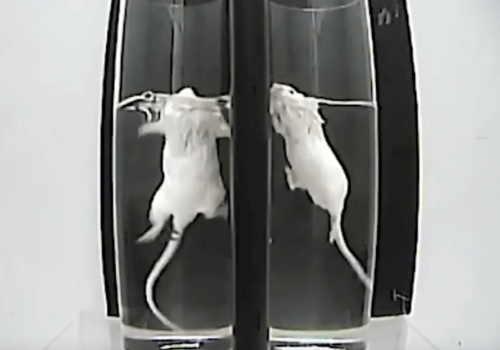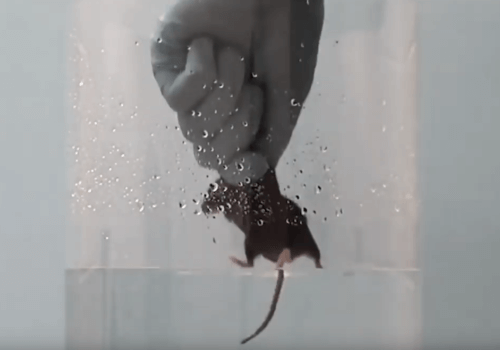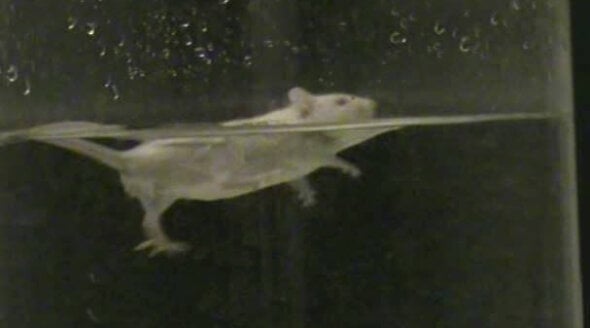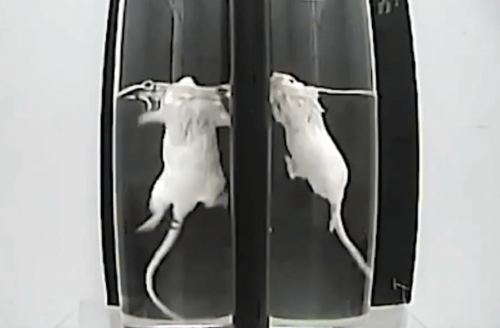7 Forced Swim Test Myths Debunked
What is the forced swim test? Does it harm mice or tell us anything about depression in humans? Below, we pick apart claims about the test and answer your frequently asked questions.
We explain why universities must ban this test, for the sake of animals, for scientific progress, and for the human patients suffering from depression, whose potential new treatments are being delayed by meaningless tests.
1. What is the forced swim test?
In the forced swim test, experimenters place mice, rats, or other small animals in inescapable containers of water and, as the name suggests, force them to swim. The animals scrabble at the sides, paddle furiously, and try to keep their heads above the water. Intermittently, they float. Some experimenters say that this test can be used to screen drugs for antidepressant properties, but this simply is not true.
It’s a harsh, unnecessary test that tells us nothing about human depression and certainly does not tell us which drugs will successfully treat it.
Alongside public campaigns urging pharmaceutical companies to ban the forced swim test, PETA has been working behind the scenes to inform universities about the lack of utility of the test. King’s College London and the University of Adelaide in Australia have both committed to ending their use of the test on all species. But some universities – like the University of Bath and the University of Bristol – are still conducting it in their laboratories.
2. Why doesn’t the forced swim test help human depression research?
Some experimenters claim that if animals float in the beaker of water for longer than anticipated, they’re showcasing depression-like behaviour. But scientific evidence suggests that animals may spend time floating because they’re adapting to their environment or trying to conserve energy.
Scientists have demonstrated that the forced swim test lacks validity for characterising emotional states1. In humans, the development of depression is a slow, complicated process, so a test that lasts six to 15 minutes cannot be used to determine depression or even symptoms of depression2.
Additionally, the forced swim test only investigates how much time an animal spends floating and ignores the many debilitating symptoms that depressed humans experience3. The notion that forcing small animals to spend a quarter of an hour in a beaker of water can tell us anything about complex neurobehavioural conditions in humans is unscientific.
3. Is the forced swim test a useful tool for screening antidepressant drugs?
No. The forced swim test does not reliably predict antidepressant activity in humans. Research does not show that all classes of antidepressant treatments increase swimming time in the forced swim test. Groups in favour of animal testing cherry-pick studies in which existing antidepressant drugs produced expected results, or “worked”, in the test, when other experiments demonstrate the opposite result4.
Some groups cite a review by Petit-Demouliere and colleagues5. Although the authors conclude that the forced swim test predicted antidepressant activity in some drug classes, they also discuss how certain antidepressants only “work” in the forced swim test under very specific conditions. If you change any of the variables below, the results of the test may be inconsistent:
• The age, sex, and even the genetic strain of the animals used in the test
• How the animals are handled and housed
• What the animals are fed
• The dose of the drug that the animal receives and when they receive that drug
• The time of day when the test is conducted
• The temperature and depth of the water
• The lighting in the room
• The presence of any odours or noises
• The duration of the procedure and the number of times it is conducted
• The particular scoring methods used by the experimenters6
A more realistic conclusion from the paper by Benoit Petit-Demouliere and colleagues would be that you may get a predictive result only if you make each variable exactly “right” and use the “right” strain of animal with the “right” drug. If one has to tinker this much with a test to get the desired result only sometimes, it’s not a sound test.
In addition, data from four pharmaceutical companies demonstrate that the forced swim test does not contribute to the development of new antidepressant drugs. PETA US scientists found that results from the forced swim test accurately predicted whether or not a compound has antidepressant properties in humans less than 50% of the time. Not a single compound used in these experiments went on to be marketed to treat depression in humans7.
4. Do we need the test to advance science?
No. There’s an urgent need to develop new, effective treatments for humans suffering from depression, but the forced swim test won’t solve this problem.
Former US National Institute of Mental Health Director Steven Hyman discussed the disappointing lack of progress in treating mental health conditions:
In the widely used forced-swim and tail-suspension tests … a compound is considered to be an antidepressant when, compared with a control, it causes a rat or mouse to continue swimming or actively struggling longer. Forced-swim and tail-suspension tests do not even model the therapeutic action of antidepressants, because in these rodent screens, a single dose of antidepressant is active, whereas in depressed patients, antidepressant drugs require weeks of administration to exert a therapeutic effect.8
Simply, we know that antidepressants take a long time to start having an effect in humans, but animals are often given just one dose of the drug before being used in the forced swim test. It’s baffling that experimenters expect this to model the human situation somehow.
Furthermore, if we’re trying to advance science and discover new antidepressants – ones that work for more patients and don’t have the harmful side effects associated with current drugs – why would we continue to use a test that was developed using precisely those old drugs?
It’s harmful to say that we have to continue to rely on the forced swim test to screen drugs for potential antidepressant qualities. The test produces misleading results, wastes the finite resources of scientists and drug developers, and squanders the precious time of the individuals who are in desperate need of better treatments.
5. Does the test harm the animals who are used?
It says it in the name: animals are forced to swim. This isn’t a brief dip in the pool or a spa day for animals. Many animals, including mice, will naturally avoid water. If they swim hard enough they can keep their noses above the water, but the sides of the beaker are slippery, and there’s no platform for them to pull themselves up on. They have no choice but to swim for as long as the experimenter desires, which can be up to 15 minutes.
6. Are pharmaceutical companies required to conduct the test?
No. In fact, in its public assessment report on the most recently approved new antidepressant, esketamine, the European Medicines Agency – the EU regulatory body that decides whether to approve new drugs for use – stated that “animal models of depression or antidepressant-sensitive behavioural tests are poorly predictive for the human situation”9.
After being asked by PETA US and its international affiliates to ban the use of this test, 14 companies and two research universities have committed to no longer conducting, commissioning, or funding the forced swim test. These are AbbVie, Astraea Therapeutics, AstraZeneca, Bayer, Boehringer Ingelheim, Bristol Myers Squibb, DSM Nutritional Products, GlaxoSmithKline, Johnson & Johnson, Novo Nordisk A/S, NutriFusion, Pfizer, Roche, Sage Therapeutics, King’s College London, and the University of Adelaide. Clearly, entities whose financial success depends on developing and marketing successful human therapeutics don’t find the forced swim test essential in their endeavours.
7. Are there non-animal methods for studying the antidepressant effects of compounds?
Yes. There are a variety of human-relevant, non-animal methods for studying human depression and developing new treatments. The relevance to humans of these new methods is key.
Anatomically, human brains are relatively unique compared with other species. In terms of the circuitry involved in psychiatric symptoms, our genes are especially different10.
Researchers at the University of Michigan used cells from human patients to create a model for bipolar disorder11. Scientists at the Mayo Clinic used human cells to explore the genes of patients with major depressive disorder and alcohol use disorder12.
These are just a few recent examples of one potential type of replacement. Of course, the forced swim test should be replaced with alternatives that are tailored to each question and the broader research goal, with the focus on human biology, not the biology of mice or rats.
Importantly, the forced swim test is not a reliable screen for antidepressants in the first place. While there’s an urgent need for advancements in mental health research, a scientifically flawed test should not be used.
Using it is like saying, “Well, rolling dice sometimes gives us the correct answer to our question, so rolling dice must be a good enough scientific method.” Any data is not necessarily good data, and – especially when that data is the result of terrifying vulnerable animals – scientists must take a step back and devote resources to identifying better methods and making the transition to using them.
What You Can Do for Mice
Join PETA in urging the University of Bath, the University of Bristol, and the pharmaceutical company Eli Lilly to ban the near-drowning of animals. Using the forced swim test in an attempt to study human mental illness is not only appallingly cruel but also utterly pointless. These experiments do nothing more than waste animals’ lives and delay the development of new, effective treatments that are desperately needed.
Send the universities and Eli Lilly a message urging them to ban the forced swim test:
1Molendijk ML, de Kloet ER. Immobility in the forced swim test is adaptive and does not reflect depression. Psychoneuroendocrinology. 2015;62:389-391.
2Belmaker RH, Agam G. Major depressive disorder. New England Journal of Medicine. 2008;358:55-68.
3Molendijk ML et al.
4Suman PR, Zerbinatti N, Theindl LC, Domingues K, Lino de Oliveira C. Failure to detect the action of antidepressants in the forced swim test in Swiss mice. Acta Neuropsychiatr. 2018;30(3):158-167. https://doi.org/10.1017/neu.2017.33.
5Petit-Demouliere B, Chenu F, Bourin M. Forced swimming test in mice: a review of antidepressant activity. Psychopharmacology (Berl). 2005;177(3):245-255. doi:10.1007/s00213-004-2048-7.
6Bogdanova OV, Kanekar S, D’Anci KE, Renshaw PF. Factors influencing behavior in the forced swim test. Physiol Behav. 2013;118:227-239. http://dx.doi.org/10.1016/j.physbeh.2013.05.012.
7Trunnell ER. Are we throwing good antidepressants out with the swim test water? LabRoots Laboratory Animal Sciences 2019. https://www.peta.org/wp-content/uploads/2019/03/LAS-2019-Poster-Dr.Emily-Trunnell.pdf.
8Hyman SE. Revolution stalled. Sci Transl Med. 2012;4(155):155cm11. https://doi.org/10.1126/scitranslmed.3003142.
9Committee for Medicinal Products for Human Use (CHMP). Assessment report: Spravato. https://www.ema.europa.eu/en/documents/assessment-report/spravato-epar-public-assessment-report_en.pdf. Published 21 November 2019. Accessed 10 November 2020.
10Hyman.
11Attili D, Schill DJ, DeLong CJ, et al. Astrocyte-derived exosomes in an iPSC model of bipolar disorder. Adv Neurobiol. 2020;25:219-235. https://doi.org/10.1007/978-3-030-45493-7_8.
12Ho M, Zhang C, Zhang L, et al. TSPAN5 influences serotonin and kynurenine: Pharmacogenomic mechanisms related to alcohol use disorder and acamprosate treatment response. Mol Psychiatry. 2020. https://doi.org/10.1038/s41380-020-0855-9.










